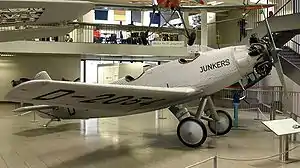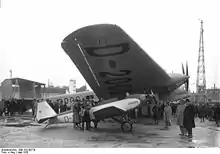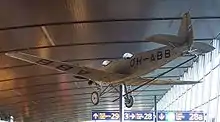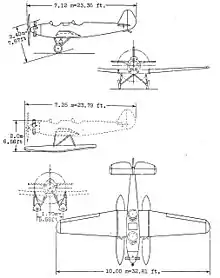Junkers A50
The Junkers A50 Junior was a German sports plane of the 1930s.
| A50 Junior | |
|---|---|
 | |
| A50ci D-2054 in Deutsches Museum Munich | |
| Role | Sports plane |
| Manufacturer | Junkers |
| Designer | Hermann Pohlmann |
| First flight | February 13, 1929 |
| Number built | 69 (original production) 27 (new production, May 2023) |
Development
The Junkers A50 was the first sportsplane designed by Hermann Pohlmann in Junkers works.[1] It had the same modern all-metal construction, covered with corrugated duralumin sheet, as larger Junkers passenger planes.[1] The first flight of the A50 took place on 13 February 1929. It was followed by further four prototypes, in order to test different engines.
Junkers expected to produce 5,000 aircraft, but stopped after manufacturing only 69, of which only 50 were sold. The high prices probably inhibited sales. Apart from Germany, they were used in several other countries and some were used by airlines. The purchase price in 1930 in the United Kingdom was between £840 and £885.[2] Starting from the A50ce variant, the wings could be folded for easier transport.
Three German A50 took part in the Challenge international touring plane competition in July 1929, taking 11th place (A50be, pilot Waldemar Roeder) and 17th place. Three A50 took part also in the Challenge 1930 next year, taking 15th (A50ce, pilot Johann Risztics), 27th and 29th places.[1] In June 1930 a series of eight FAI world records for altitude, range and average speed were set on a floatplane variant of A50 with the Armstrong Siddeley 59 kW (79 hp) engine. In 1931 Marga von Etzdorf flew an A50 solo from Berlin to Tokyo, the first woman to do so.
Design

Metal construction sports plane, conventional in layout, with low cantilever wings, stressed corrugated duralumin covered.[1] Two-spar wings were folding rearwards or could be detached.[1] Crew of two, sitting in tandem in separate open cockpits (if it flew without a passenger, one cockpit could be closed with a cover). Two-blade propeller. Conventional fixed split axle mainwheel landing gear, with a rear skid.
New production
.jpg.webp)
In 2022, Junkers Aircraft Works began production of a modernized version of the A50. This new A50 features modern avionics, a 100 hp Rotax 912iS engine driving a composite MT-Propeller, and a ballistic parachute. As of May 2023, 27 new A50s have sold in Europe, and plans have been made for WACO Aircraft Corporation to produce aircraft for American customers.[3][4][5]
Variants
- A50 - Armstrong Siddeley Genet 59 kW (79 hp) radial engine
- A50ba - Walter Vega 63 kW (84 hp) radial engine (one built)
- A50be - Armstrong Siddeley Genet 59 kW (79 hp) engine
- A50ce - Armstrong Siddeley Genet II 63 kW (84 hp) engine or for export Genet Major I 74 kW, folding wings
- A50ci - Siemens-Halske Sh 13, 65 kW (87 hp) radial engine, folding wings. Originally designed to be mass-produced as a "Volksflugzeug".[6]
- A50fe - Armstrong Siddeley Genet II, 63 kW (84 hp) engine, modified airframe, folding wings
- KXJ1 - A single Junkers A-50 supplied to the Imperial Japanese Navy Air Service for evaluation.
The -ce and -ci variants were produced in the largest numbers with about 25 of each on the German civil register.[7] Due to their construction, the A50 were durable aircraft and they lasted long in service. The last plane was used in the 1960s in Finland.[1] There is one A50 preserved in Deutsches Museum in Munich and another in Helsinki airport. One A50 (VH-UCC, c/n 3517) is in airworthy condition in Australia.
Operators

- Bolivian Air Force - 3 A50s transferred from Lloyd Aéreo Boliviano during Chaco War[8]
- Lloyd Aéreo Boliviano - 3 A50s used for training and light transport[9]
- South African Air Force
- South African Airways operated three aircraft
Surviving aircraft
An example is currently on display in Helsinki Airport. Registered as OH-ABB, it was flown by Väinö Bremer to Cape Town in a historic flight.
Specifications (A50ba)

Data from Junkers aircraft and engines, 1913-1945,[12] Junkers: an aircraft album[13]
General characteristics
- Length: 7.12 m (23 ft 4 in)
- Wingspan: 10 m (32 ft 10 in)
- Height: 2.39 m (7 ft 10 in)
- Wing area: 13.7 m2 (147 sq ft)
- Empty weight: 340 kg (750 lb)
- Gross weight: 590 kg (1,301 lb)
- Fuel capacity: 95 L (25 US gal; 21 imp gal)
- Powerplant: 1 × Armstrong Siddeley Genet II 5-cylinder air-cooled radial piston engine, 65 kW (87 hp)
- Propellers: 2-bladed fixed-pitch propeller
Performance
- Maximum speed: 164 km/h (102 mph, 89 kn)
- Cruise speed: 140 km/h (87 mph, 76 kn) on 60% power
- Landing speed: 75 km/h (47 mph; 40 kn)
- Range: 600 km (370 mi, 320 nmi)
- Endurance: 5 hours
- Service ceiling: 4,200 m (13,800 ft)
- Time to altitude: 3,000 m (9,800 ft) in 21 minutes
- Take-off run (over 8 m (26 ft)-high gate): 250 m (820 ft)[14]
- Landing run (over 8 m (26 ft)-high gate): 187 m (614 ft)[14]
References
- (in Polish) Krzyżan, Marian. Międzynarodowe turnieje lotnicze 1929-1934 [International aviation competitions 1929-1934], Warsaw 1988, ISBN 83-206-0637-3
- Junkers Junior, Flight, April 4, 1930.
- Horne, Thomas A. (2023-02-05). "Yesterday's wings, today: Reimagining a classic". www.aopa.org. Archived from the original on 2023-08-02. Retrieved 2023-08-02.
- Boatman, Julie (2023-03-28). "Junkers A50 Junior Unveiled to Kick Off Sun 'n Fun 2023". FLYING Magazine. Archived from the original on 2023-08-02. Retrieved 2023-08-02.
- "Futuristic retro: Junkers reintroduces A50 Junior — General Aviation News". generalaviationnews.com. 2022-11-07. Archived from the original on 2023-08-02. Retrieved 2023-08-02.
- Junkers-F13-and-A50
- "Golden Years of Aviation - Main". Archived from the original on 2012-02-19. Retrieved 2012-05-30.
- Tincopa & Rivas 2016, p. 61
- Tincopa & Rivas 2016, p. 59
- Tincopa & Rivas 2016, p. 203
- Tincopa & Rivas 2016, p. 343
- Kay, Anthony L. (2004). Junkers aircraft and engines, 1913-1945 (1st ed.). London: Putnam Aeronautical Books. pp. 95–97. ISBN 0851779859.
- Turner, P. St.J.; Nowarra, Heinz J. (1971). Junkers: an aircraft album. New York: Arco Publishing Inc. pp. 54–57. ISBN 0-668-02506-9.
- Best take-off and landing results from Challenge 1930 competition (Krzyzan, op.cit., Table II)